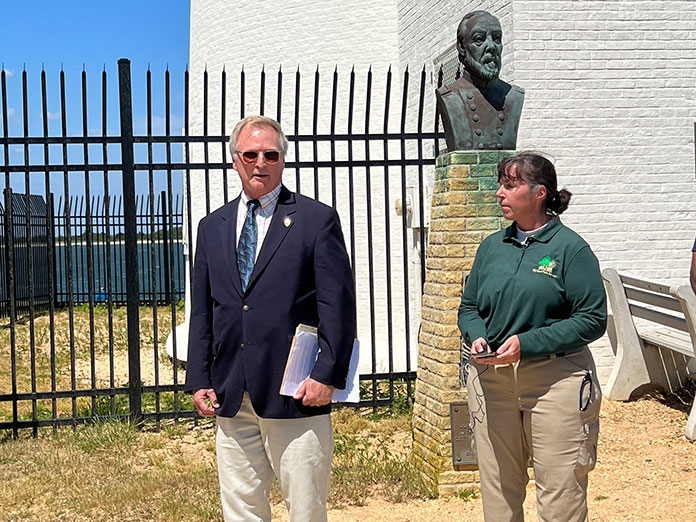
BARNEGAT LIGHT – After a $1.3 million restoration project, the Barnegat Lighthouse, affectionately known as Old Barney, reopened its doors to the public. In just two days, nearly 1,000 visitors ventured inside to climb the 217 steps to the top and take in the spectacular views of the surrounding area.
Visitors who are unable or hesitant to ascend the winding staircase leading to the pinnacle of the lighthouse can now enjoy a breathtaking panoramic view through newly installed cameras. Presently, the livestream is exclusively accessible for viewing at the Visitor Center, but plans are underway to make it readily available on the Barnegat Lighthouse State Park website, maintained by the New Jersey Department of Environmental Protection.

The restoration project began with a primary focus on the lighthouse exterior, with masonry recoating, painting, roof repairs and window replacements. Additionally, significant interior repairs were carried out, particularly targeting the steel platform of the lantern. Other essential interior renovations included tasks like painting, lightbulb replacement, and thorough cleaning.
“To cap off all of this work, we had a donation from Friends of the Barnegat Lighthouse, of the lantern, the beacon light on top and the security fencing around the lighthouse,” said Rebecca Fitzgerald, Administrator of the State Park Service.
The tall black aluminum fence replaces a chain-link fence that existed before the lighthouse restoration project.

Mark Texel, Administrator of State Historic Sites, provided some intriguing insights into Old Barney. He revealed that the Barnegat Lighthouse is among the six lighthouses managed by the state, with two of them being staffed by park staff volunteers. The Navesink Lighthouse in Highlands is the other lighthouse under their supervision.
“There’s been a lighthouse at this location since 1834,” Texel shared. “The reason this is an important spot is because we know the shoals are very dangerous.”
Originally constructed as a wooden structure, the lighthouse served as a warning to sailors, urging them to stay away from the treacherous shoals.
The recently restored lighthouse, designed by Jim Will George Gordon Mead in 1857, stands as a testament to architectural brilliance. Its first lighting in 1859 drew a crowd of 200 spectators, witnessing the inaugural use of a Fresnel lens imported from France. Today, the lighthouse boasts a newer LED Fresnel lens, that can be seen for a distance of 21.5 nautical miles.

Over the years, the lighthouse has undergone many transformations. Its history includes use as a lookout tower during World War II, when it was used to spot enemy ships along the surrounding waters.
In 1957, the lighthouse became a state park and formally opened to the public. Its popularity enhanced further when a jetty was constructed in 1991 and attracted people who enjoyed walking along the water’s edge or throwing rods into the surf.
“Fourteen years ago, the lighthouse was relit for the first time since it was extinguished (in 1926),” said Texel. “There were 8,000 people in attendance.”

To fully experience the breathtaking scene from the top of the lighthouse, visitors must take note that operational hours are from 9 a.m. to 3 p.m. A dedicated volunteer diligently tallies the number of individuals entering, managing the traffic on the steps leading both up and down the historic structure.






